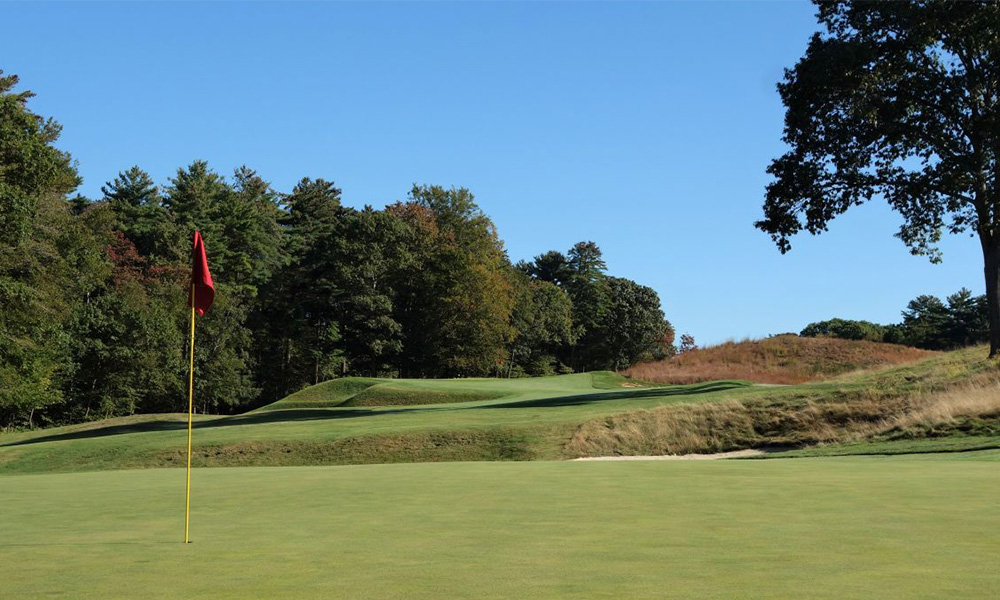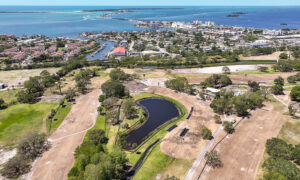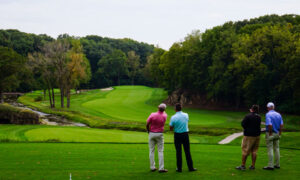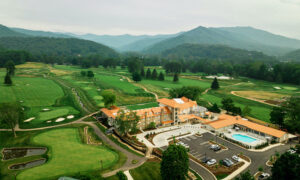The tournament, officially titled the “Women’s International Cup,” is the most famous team competition for amateur women golfers, co-sponsored by the United States Golf Association and the Ladies’ Golf Union. The Curtis Cup is a biennial women’s amateur team competition played between eight-member teams from the United States of America, Great Britain, and Ireland.
Currently, the United States leads Great Britain and Ireland 26-6-3. The Curtis Cup has strong roots at Essex County Club. The Match is named in recognition of the efforts of two Essex members, Margaret and Harriot Curtis, in starting the event. Both sisters were U.S. Women’s Amateur champions. Harriot won in 1906 and Margaret won in 1907, 1911, and 1912. The trophy that is presented to the winner of the tournament has an engraving on it that best represents the Curtis Cup: “To stimulate friendly rivalry among the women golfers of many lands.” In many ways, the Curtis Cup is a throwback kind of tournament that is steeped in tradition and national pride. Essex County Club hosted the Curtis Cup Match in 1938, won by the United States team. The Curtis Cup will be held at Essex County Club on June 11th … 13th of 2010. This past year it was held at the most historic of places, the Old Course at St. Andrews. A saying that has become popular is that “the Curtis Cup is coming from the home of golf to the home of the Curtis sisters”.
In May of 2008, the United States of America took home the Curtis Cup for the sixth consecutive time with a 13 … 7 win. To lead the squad Stacy Lewis and Alison Walshe made it through the tournament undefeated. Stacy Lewis was 23 years old at the time and is from The Woodlands, Texas. She went a perfect 5-0 for the United States, with two foursomes (alternate shot) and two four-ball (best ball) victories on Friday and Saturday of the tournament. Then on Sunday, she won 3 and 2 in her singles match over Scotland’s Liz Bennett, which happened to be the winning point for the United States.
This is an amateur event so you may not recognize many of the participants. But, in a few years, they may end up becoming some of the most prominent names in women’s golf. Just for starters, Nancy Lopez, Michelle Wie, Juli Inkster, Paula Creamer, and Dottie Pepper have all participated in previous Curtis Cup matches.
This will be the fourth Curtis Cup to be held in New England; Essex County Club in 1938 and 2010, Brae Burn Country Club (located in West Newton, MA) in 1958 and 1970. In my mind, Essex County Club is the perfect setting for this tournament. I believe this not just because I am employed by the club or because the Curtis sisters were members at Essex, but because there is, not unlike many other clubs in New England, a rich and storied history attached to Essex County Club. Essex County Club is located in Manchester-by-the-sea, Massachusetts which lies about 25 miles north of Boston. Although the St. Andrew Club in New York and the Country Club in Brookline brought golf to the United States and New England, Essex opened in 1893 and was the first nine-hole golf course in New England. Only a delay in the 1893 U.S. mail prevented Essex from becoming one of the five charter members of the USGA (Essex was admitted 6th). In 1917, Essex County Club expanded from 9 to 18 holes when Donald Ross, the world-famous architect, finished his work at Essex. Ross started his work in 1909 when he became a Club Professional. He lived and worked on the golf course, his house still sits overlooking the 15th hole.
Related: New England Golf Course Superintendents Are Getting the Job Done
In preparation for the tournament, the club has pushed forward with an extensive restoration project. When Essex received the Curtis Cup, the USGA stated “we can play the golf course as is”. But, under the direction of Essex’s architectural consultant, Bruce Hepner of Renaissance Golf Design Inc., and with the approval and support of the Greens Committee, Chairman, and Club President, implementation of a master plan originally adopted in 2002 has quickly moved forward. The restoration projects have dealt with many areas that will dramatically improve the appearance and playability of the golf course for the players, television audience, and the patrons who attend the Curtis Cup. Up until the fall of 2007, much of the focus, and rightly so, was placed on drainage and infrastructure. Beginning in October of 2007, there have been many cosmetic changes to the golf course. To date, there have been 1200 trees removed; which has opened up many vistas that have been lost for decades. We have also been busy restoring bunkers, leveling tees, moving cart paths and restoring native areas (Tall Rough). The track taken by the club in adopting the master plan is to restore the golf course to Donald Ross’s original design and intent, but not to make the golf course harder or easier to play.
The picture of a hill behind #11 green was a lost feature due to the planting of pine trees four or five decades ago. As you can see in the third from the top picture (after) there have been some significant changes. Much if not all of the tree work that has taken place over the last few years has not just helped restore the golf course, but has decreased some major agronomic issues in each area by increasing air movement and light to putting green surfaces and sensitive turf areas.
The Curtis Cup will be televised on the golf channel and the club expects attendance to be anywhere from 3,000 to 4,000 patrons. It is a “Ryder Cup” format match play tournament. In 2008, the Old Course at St. Andrews had anywhere from 10,000 to 15,000 patrons attending each day. This was most likely due to the venue, but this tournament seems to resonate more in England and Ireland than here in the United States. In 2010, the Curtis Cup should be a forum to show the world what New England has to offer. The Curtis Cup also offers an opportunity for people to discuss the very rich championship golf history that has and continues to be made in New England, not to mention the great golf courses. The Curtis Cup will be seen worldwide (110 media credentials, so far). That is why the club and I need all the help we can get from you. I have begun the formal process of trying to recruit some Grounds volunteers for the tournament. If you would like to volunteer for the Curtis Cup, please contact me, my information is listed below.
Eric Richardson, GCS
Essex County Club
978-526-4600
grounds@essexcc.org



























